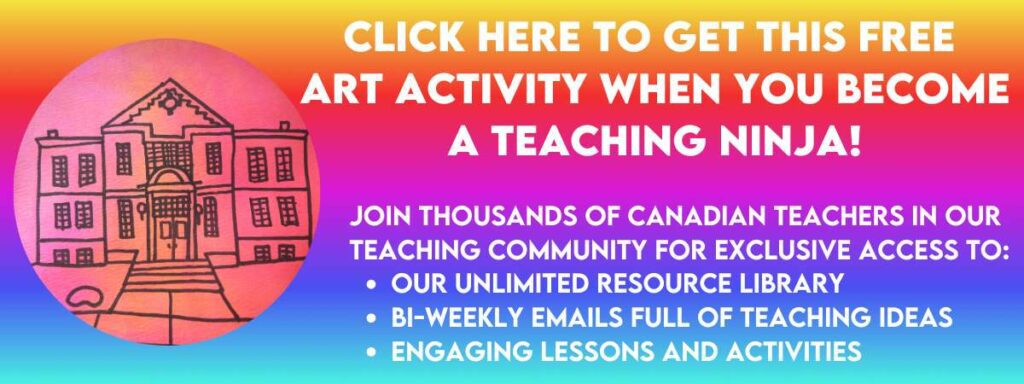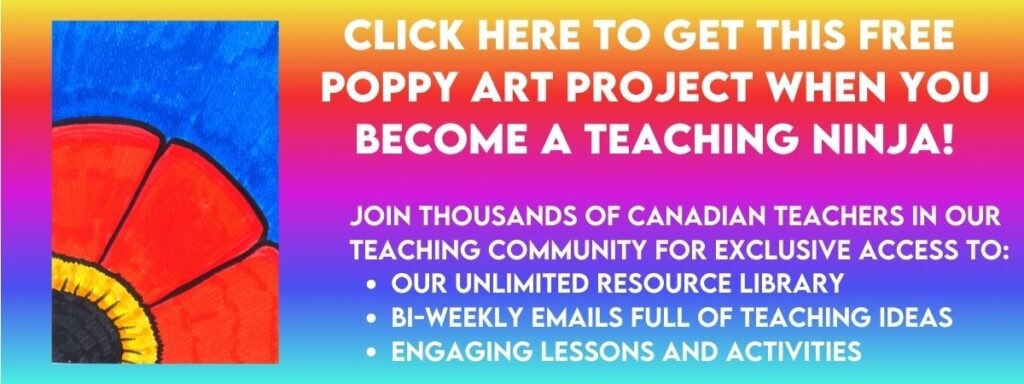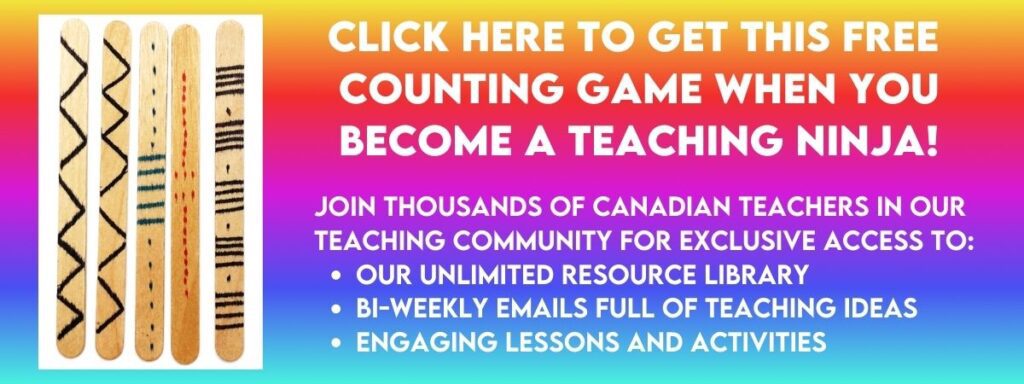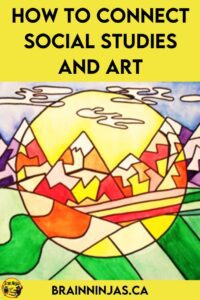
In Canada, elementary teachers teach all the subject areas in most schools-except specialties like French or music. This means generalist teachers like us are expected to teach art, even when we aren’t trained artists. Our students have been known to question some of our drawings over the years, so we’ve had to be creative in finding projects we can teach our students that help them learn, but don’t stress us out. We want to share ways to connect social studies and art with all of you.
The most natural place to connect subject areas is by incorporating art into the lessons. It’s easy to think a little colouring will be enough art each week, but it’s important to create art projects that teach actual art skills. We created several lessons around the landscapes and geography we were studying about Canada while building art skills such as drawing, sculpting, painting and printmaking. Once we started connecting our social studies lessons to art projects, we recognized the potential.
Students can learn social studies while they learn art skills at the same time (and they can learn other subject areas too, but we’ll save that for another time).
If you have been avoiding teaching art because of the mess, you need to read this post we wrote about this very problem.
Why should you integrate art into your social studies lessons?
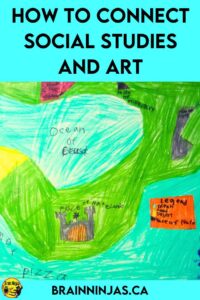
Once we decided we were going to try this, we needed to find some science to back up our decision (just in case anyone implied that our students weren’t really “doing” social studies). It wasn’t hard to find study after study that supported teaching art to young students. It helps them academically, socially and even emotionally.
Some students cannot express everything they learn in written form or by speaking, so when you provide opportunities for students to show their understanding through art, they have yet another way to show they learned. Often students who struggle with writing thrive in art class.
Students who love being artistic will be more engaged during your social studies lessons when they know that will have the chance to express their learning creatively.
Art teaches students to visualize. This is a comprehension skill usually taught in reading, but after the first few grades of school, students shouldn’t be learning to read; they should be reading to learn. Giving them an opportunity to visualize what they are learning in social studies will help them understand the information more deeply.
But before you do this…
Allowing students to show their learning in non-traditional forms means giving up a bit of control. You are going to have to let students be messy and make mistakes.
Newsflash: art is messy.
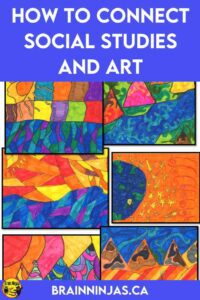
You do not have to be the perfect artist, but you do need to have an artist’s mindset in that creativity doesn’t happen in a perfectly clean room. It means having different media available and projects that will be half-done for periods of time while students are trying to finish up. It means giving students time to work and some students will take longer than others.
You can still be organized, but you’ll need to have readily available material so students can choose their media (when appropriate). Most of the materials we mention in this post are things you can readily find in most school art storage closets.
Create a routine for set-up and take down that all your students will learn and use. For example, in our class we have a rule that no one walks with a paint palette, brush with paint on it or a wet painting. We leave those things at the spot they were used until it is time to clean up. This way no one accidentally drops a wet painting on someone else’s or pokes each other in the back with a paintbrush leaving a nice red dot in the middle of someone’s back (that rule may have been created based on a personal experience).
How will tables/desks get wiped down. Who will clean the brushes (and where)? Who will pour the paint?
Think about all the things you will need in order for your students to take on the responsibility of cleaning up (thus saving your time and your sanity).
What types of social studies lessons can be taught with art?
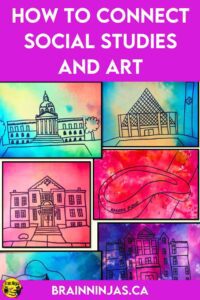
It’s easy enough to teach students about different landforms and landscapes, but you really get a sense of student understanding when you incorporate art. They get to be creative and you get to see what they really know and understand about different geographical features.
Sometimes we plan out these projects in advance and sometimes the creativity of our students inspires us in ways we never would have expected-making whole new lessons.
We encourage students to look at photographs of different geographical features and then recreate them using a set of art skills. We’ve even gone on sketching and photography trips around our city for inspiration.
We created a product out of some of the best landscape and geography creations we, along with our students, have made over the past few years. There are enough lessons to keep you busy for months, but more importantly, you can be creative with your students and call it social studies or geography. Each lesson comes with detailed steps and examples. Photographs of the steps are included when it is easier than trying to explain. Find the Geography and Landscape Art Lessons in our TpT Store ($USD) or BN Shop ($CAN).
Geography
Art can be used naturally for geography, but it can also be used for mapping skills. Students can create maps that are artistic and beautiful. We have a set of mapping skills lessons that we do at the beginning of every school year. We finish the unit with an activity where students create a map of themselves. It is a very popular lesson and some parents keep the maps forever. You can find that lesson in our Mapping Skills Unit on TpT($USD) or our BN Shop ($CAN).
Cultures
You can use art to teach about different cultures. For example, you can look up the artists from any country and look at how they incorporate their own culture into their art. Looking up Canadian artists that inspired us led to us creating lessons that feature Canadian artists. Find Canadian Artists Inspired Art Lessons in our TpT Store ($USD) or BN Shop ($CAN).
We have been learning about how the Indigenous People in Canada have contributed to Canadian history and culture. Our students researched different Indigenous people and many of them are artists, singers and authors. We looked at some of the works of these people and they inspired us to create lessons based on some of the artists’ styles. You can find Indigenous Artists Inspired Art Lessons in our TpT Store ($USD) or BN Shop ($CAN).
If you’d like to try a lesson, read Explore Metis Storytelling Through Indigenous Art Lessons.
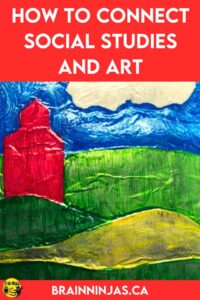
In fact, many of the art lessons we’ve created were experiments that just turned out. There were lots of flops along the way, but learning simple techniques can work for anyone.
What art skills do you need?
Frankly, none. But, you should be prepared to try things out. Painting with different types of paint and brushes can lead to all kinds of things. All you have to do to create a social studies lesson that integrates art is to think of some of the social studies topics and then allow students to create something artistic-it’s that simple. You don’t have to have specific projects, but instead have a set of skills that apply to almost any lesson.
Paint something: a landscape, a historical person, a historical place, a replica of a piece of art, a map of a place, an event, feelings about historical events
Media: use any paint your school has: Tempera, watercolour, acrylic, India ink, markers (sprayed with water) or brushes (including non-standard brushes like toothbrushes, stamps, cardboard
Draw something: a landscape, a historical person, a historical place, a replica of a piece of art, a map of a place, an event, or how an event made the student feel
Media: use pencils, charcoal, pastels, markers, crayons, chalk, conté or pencil crayons, erasers, computer programs
Act Something Out: a landscape, a historical place, a replica of a piece of art, a map of a place, avoid acting as people or specific events that could be harmful to students or specific groups of people
Drama: create a space for your students to act out what they have learned. For more ideas check out this blog post called Add Some Drama to Your Classroom.
Sculpt Something: a landscape, a historical person, a historical place, a replica of a piece of art, a version of your perspective, a map of a place, an event, a diorama of a scene
Media: clay, soap, soapstone, plasticine, paper, papier-mâché, cardboard, glue, wax, Plaster of Paris, plastic, found objects
Other art forms that you can try: singing, dancing, photography, cinematography, cartography, puppeteering, costume design, stage design, poetry, playwriting
What else can you use art for?
Art can be used to tell world history. Students love to create comics. What better way to retell an event than to draw it through pictures? Your students will surprise you (even if you think you cannot draw).
One pager: These are assignments where students create the entire task on one page. We created a perspective of the War of 1812 with our students. It was very interesting to see what students drew about after learning about the war. It helped us understand what they understood about the war (and what they didn’t quite get right).
Folk Art: Art has changed over time. Have your students explore different art from different cultures at different times and then compare them.
Transformations: Use art to show how things have changed over time. Compare your community one hundred years ago to the modern day. How have people changed? Has the landscape changed? How did the Industrial Revolution change Europe? The lesson plan practically writes itself.
Heroes and Legends: Create visual representations of heroes and their stories.
Visual Timelines: Instead of a list of dates, have students create icons for each of the dates to represent the event.
Symbolism: Students can research different symbols that are used throughout history and paint, draw or display them. One symbol we use around Remembrance Day is the poppy. You can get a copy of our lesson here or find it in our Resource Library.
Don’t forget to display the art
After all the work your students have put in, make sure that you show it off. The easiest way is usually a bulletin board, but there are other ways:
- host an art walk
- digitize it and write a blog
- take photos and upload them to your school website or newsletter
- create a slide show
- host a performance
- post pictures on Seesaw (or your parent communication app)
- invite other classes to come to visit your display and have students act like tour guides at an art gallery
- create a live museum display
- enter the art into contests in your area
We aren’t artists in the traditional sense of the word, but we love creating things. This spirit is what our students notice the most when we teach them art. They see that we are willing to try and make mistakes (and messes) and that not everything works out the way we want the first time we try.
We teach students how to keep trying. We model how to try over and over some days. Sometimes these lessons are even more important than all the art ones.
When you allow students to create in different ways, they find their learning more meaningful. We have other ways we share our love of social studies. You should read our post: Bring Social Studies to Life.
If you’re looking for other ways to bring culture into the classroom, try playing a game from another culture. You can find the Bone Game in our Resource Library or we can send it to you by email when you sign up for our list.
Are you inspired? What are your thoughts on integrating art with social studies? Are you willing to give it a try? Let us know in the comments below. We’d love to hear your thoughts.

